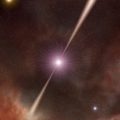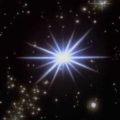
Astronomers from the European Southern Observatory have set a new astronomical record by observing the afterglow of the most distant gamma ray burst ever. The Italian astronomers said the afterglow had a measured red-shift of 6.3, meaning the light has taken 12.7 billion years to reach Earth. Science’s best estimates put the age of the Universe at around 13.5 billion years, so the gamma ray burst occurred very early on in the life of the Universe, when it was less than 900 million years old.
Gamma ray bursts are short flashes of energetic gamma-rays, lasting up to several minutes, which release tremendous quantities of energy. Astronomers hypothesize that the majority of gamma ray bursts signal the explosion of very massive stars that then collapse into black holes.
The burst, named GRB050904, was first detected on September 4, 2005, by the Swift satellite. Immediately following this initial detection, astronomers in observatories worldwide tried to identify the source by searching for the afterglow in the visible and near-infrared, spectrum. Observations by a team of American astronomers first detected the source in the near-infrared band. Italian astronomers then used one of four telescopes that comprise ESO’s Very Large Telescope to observe the object in the near-infrared and visible spectrum. By comparing the brightness of the source in different parts of the spectrum, the astronomers could deduce its red-shift and, hence, its distance. The astronomers said the observations were carried out between 24.7 and 26 hours after the burst.
While the discovery sets a new astronomical record, its main value will be in helping us understand the fundamentals of the Universe as it existed in the distant past. Because gamma ray bursts are so luminous, they have the potential to outshine even the most distant known galaxies allowing us to probe the Universe at very high red-shifts. And because gamma ray bursts are thought to be associated with the catastrophic death of very massive stars that collapse into black holes, the existence of such objects so early in the life of the Universe provide astronomers with important information to better understand the Universe’s evolution.












Comments are closed.